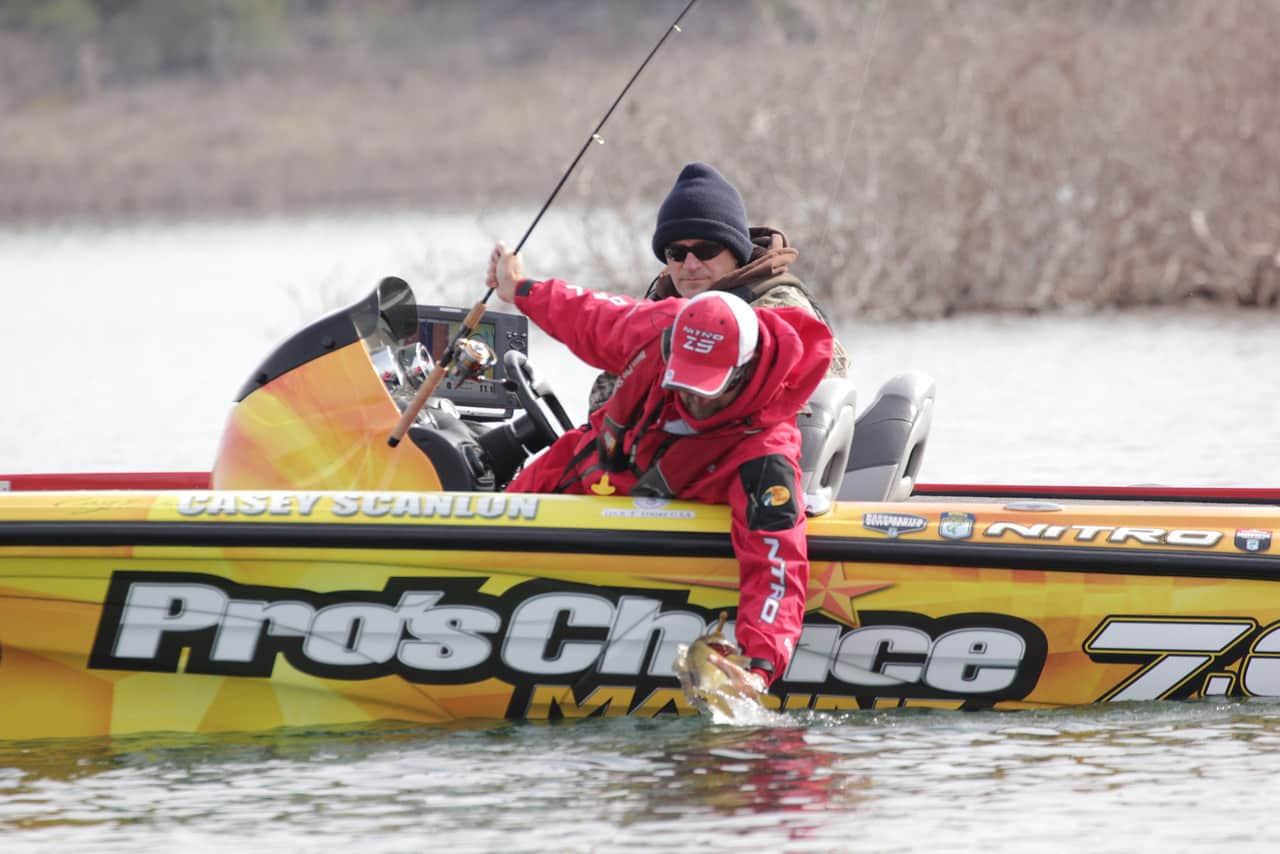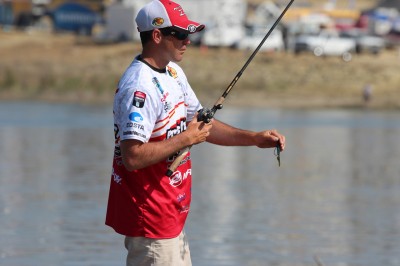Stop Fishing the Bank and Find the Brush Piles
OutdoorHub Contributors 09.03.13

Do you want to be a better tournament fisherman? Stop fishing the bank and find the brush piles. They are in every man-made reservoir across the country. A state’s wildlife department, crappie fishermen, and tournament anglers place most of them. The key to utilizing brush piles is finding them at the correct depth, figuring out the location of the best brush piles, and using the correct baits.
Bass will use brush piles all year long, but my favorite time to fish them is in the summer. Once the fish make their way out to them, they usually stay there for several months, where they are easy to target and catch. Once you find the correct depth and the kind of banks they are relating to, you can duplicate this pattern and create a milk run of spots all over the lake. This is a great way to catch quality tournament-winning fish with consistency.
Depth
After the spawn, females abandon their nests and leave the smaller male bass up shallow to protect and guard fry. These larger female bass will move out to slightly deeper waters around gravel-spawning flats and pockets in order to seek shelter. Female bass will use shallower piles, in six to 12 feet, to recover from the stressful spawning process and feed to regain strength. These fish can be hard to catch immediately after the spawn, but after a couple of weeks, they begin feeding heavily.
Start your search for brush piles on the first slight drop or shallow tapering points outside of spawning pockets. If you can find these productive piles just after the spawn, you can catch some heavy stringers while others are still beating the banks catching skinny post-spawn males.
As the water warms up and fish start to move to deeper summer haunts, you need to look for deeper brush piles. Usually the 12- to 18-foot range works best.
The depth of a productive brush pile will depend on water clarity. If a lake has just a few inches of visibility, the most productive brush will be shallower. If the lake has 15 feet of visibility or more, the most productive depth will be 25 to 40 feet of water. No matter the depth, I like for them to be away from the bank where the average fisherman overlooks them.
It can be difficult and time-consuming, but many anglers don’t put the work in to find them. If you put in the time, you can have a place all to yourself that reloads with fish consistently day after day. You also have a good chance to catch some big fish.
Location
The type of brush piles I look for during the summer months are the ones that have branches extending out. I like for the pile to be pretty good-sized so it can hold a number of fish, with a lot of branches to create shade and plenty of space between the branches for the fish to swim around inside the pile. Sycamore or willow trees seem to make the best brush piles in the central part of the country. More importantly, though, is where the brush is located.
Many anglers look for brush on points and ledges in the summertime, and I do, too, but these areas are easily found by other fishermen and become less productive. My most consistent pattern in the summer is finding brush piles on “do nothing” banks. Usually when you find a brush pile in this area, most fishermen overlook it—giving you a special spot to yourself. I focus on mud or gravel flats that are off the main lake.
It also helps to have a major spawning area and the main river channel in the vicinity. Shad use these flats all summer, and so do the bass. Because these banks are void of cover, the bass tend to roam, chasing shad, and become very hard to target and catch. When you find brush piles in these areas, it gives the bass protection and a place to feed, and it gives you an easy, isolated target to throw to and pick them off.

Baits
There are three main baits I recommend when fishing brush piles: a ribbon-tailed worm, a jig, and a crankbait.
I cast a 9-1/2-inch Luck “E” Strike Ringworm in a variety of colors, but you can never go wrong with something purple or close to it. I use a 1/2-ounce or 3/8-ounce Bass Pro Shops tungsten bullet weight with the worm Texas-rigged. I cast past the brush pile and drag it slowly into it. I like to make sure the worm is always on the bottom.
Once the worm gets to the brush pile, I’ll slowly work it over the branches. After I pull it over a branch, I’ll let it sink to the bottom. Then I’ll slowly lift my rod tip up and down a few inches, which gives the worm an enticing yo-yo action that can produce a strike. If a fish doesn’t take it, I’ll pull it over the next branch and repeat the process.
I’ll make many casts to the brush from different angles trying to cover the entire pile and the area immediately surrounding it. The fun part about fishing brush in the summer is that they usually bite within the first few casts, and then you can work around it to catch a few more. If they don’t bite right away, don’t disregard the brush pile. It’s a good idea to make a return trip at a different time in the day when they might be biting.
I use a seven-foot, six-inch heavy Razr Platinum rod when I’m dragging a worm on the bottom. I pair this rod with a Johnny Morris Carbonlite baitcast reel with a 7:1.1 gear ratio. My choice of line is 20-pound fluorocarbon. When I set the hook, I set it hard and pull them out quick. I’m trying to get the bass out as fast as possible so it does not wrap my line around a limb. So you need to have a stiff rod that has the ability to work the fish quickly to the boat.
My second lure choice is a 5/8-ounce jig. I use the same rod, reel, and line set-up as I did with the worm. I’m really focused on keeping it on the bottom. Like the worm, I drag the jig through the brush trying to keep it on the bottom. When I pull it over a branch, I let it fall to the bottom and move it up and down before pulling it over the next limb.
I mostly use a Luck “E” Strike green pumpkin jig that has some green flash to it. My favorite jig colors are green pumpkin, green flash, or peanut butter and jelly. I will use a black and blue jig in dirty water. I most often use a Bass Pro Shops XPS five-inch twin tail grub as a trailer. I will use a variety of trailer colors in order to match the jig I’m using, but most often it’s green pumpkin.
My third lure of choice for fishing brush is a deep crankbait. The Luck “E” Strike Deep Smoothie and the new Freak work well for this. Both of these baits are very buoyant, which helps them back away from the cover after contact, reducing snags. The Freak has a unique square bill that allows it to deflect off cover better than traditional round-lipped, deep-diving cranks. I fish both on 12-pound fluorocarbon line so they are able to achieve maximum depth. I use the Deep Smoothie for brush in 15 feet or less and the Freak for anything deeper than 15 feet.
I use the Casey Scanlon Signature Razr rod for my crankbaits. This is a seven-foot, 10-inch rod made of fiberglass that is specially designed to throw bigger crankbaits with ease and less fatigue. The longer rod allows you to throw the bait farther, which helps the bait stay at maximum depth longer and stay in the strike zone longer. The fiberglass rod helps reduce fatigue and increase the ability to land your fish.
Obviously, a crankbait is going to get hung up, but it is well worth the sacrifice and aggravation to catch some really big bags of fish. When throwing the crankbait, I try to crash the bait into the pile and pause it allowing it to back away from the cover. If the strike doesn’t occur after the crash, slowly crank the lure through the limbs, feeling your way through the brush.
Try throwing to the side of brush before working your way to the middle. When you do get hung, load up your rod, and point it toward the bait, then snap your line with the opposite hand. That will give it some slack and allow it to float up. Have a plug-knocker close by as a last resort. These are worth their weight in gold and will get most of your crankbaits back.
When I won the Central Open on Table Rock last year, I caught most of my bigger fish in brush piles. I had a three-day total of 49 pounds, four ounces, won over $50,000, and qualified for my first Bassmaster Classic. So, speaking from experience, finding the right brush piles can help you win tournaments.
Like so many techniques, fishing brush piles takes some practice. Break out of the mold of fishing the bank and put the time in to find the right brush piles. Keep in mind the tips I’ve given you in this article. Find the correct depth, the best location; and using the right bait, you can catch some giant bass this summer.
Scanlon fishes the Elite Series with B.A.S.S. You can read more articles by him on his Facebook page or at his website.

